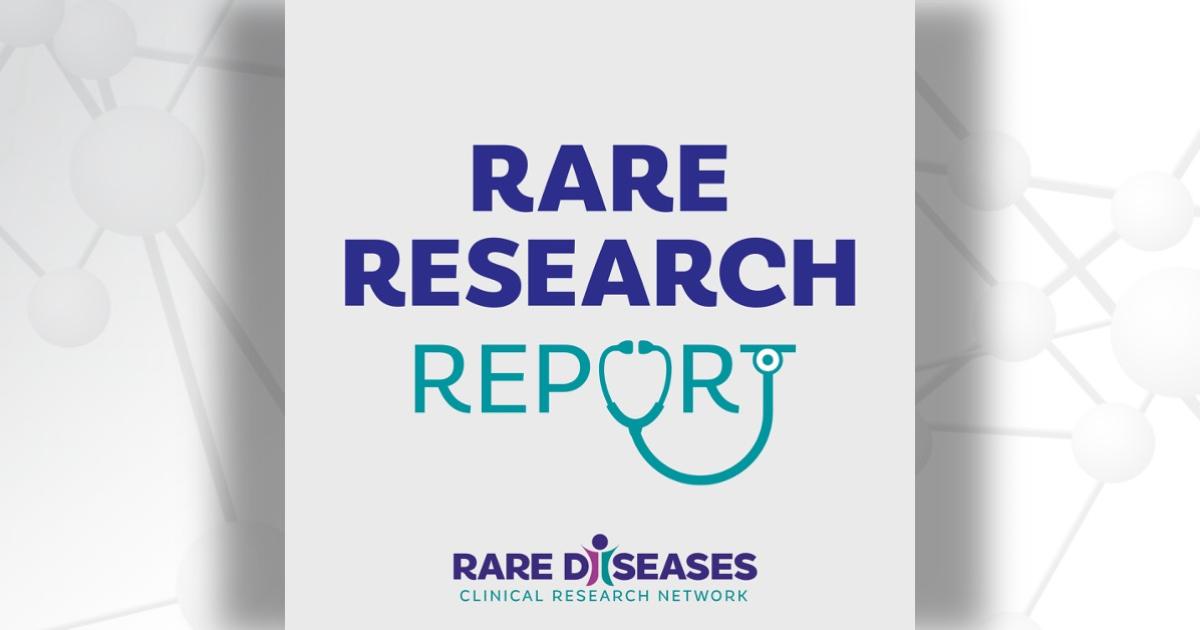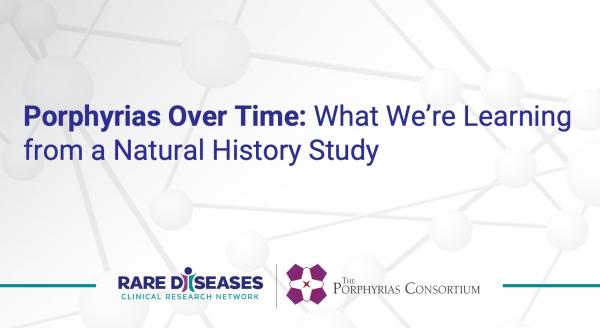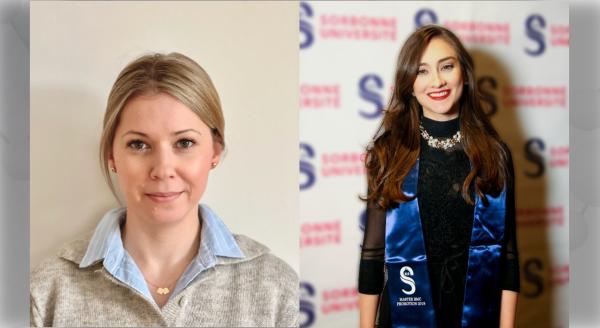Each month, we share summaries of recent Rare Diseases Clinical Research Network (RDCRN) grant-funded publications. Catch up on the latest RDCRN research below.
Jump to:
- Brain Vascular Malformation Consortium (BVMC)
- Developmental Synaptopathies Consortium (DSC)
- Dystonia Coalition (DC)
- Genetic Disorders of Mucociliary Clearance Consortium (GDMCC)
- Global Leukodystrophy Initiative Clinical Trials Network (GLIA-CTN)
Listen to these summaries on the Rare Research Report podcast.
Brain Vascular Malformation Consortium (BVMC)
Hereditary hemorrhagic telangiectasia (HHT) is an inherited disorder of the blood vessels that can cause chronic bleeding. People with HHT can experience brain arteriovenous malformations (BAVMs), which are tangles of blood vessels with abnormal connections between arteries and veins in the brain. In children with sporadic (non-HHT) BAVMs, angiography—an X-ray-based image of the blood vessels—can be used to assess the BAVM nidus compactness score, which helps predict BAVM recurrence after surgical removal.
In this study, researchers measured the angiographic compactness score for BAVMs in children with HHT. The team reviewed angiograms from 47 children with HHT in the Brain Vascular Malformation Consortium.
Results show that children with HHT have a range of compactness scores, suggesting the usefulness of these scores for future studies of BAVM recurrence and hemorrhage risk in children with HHT. The authors note that these studies could help direct BAVM treatment in the future.
Beslow LA, Vossough A, Kim H, Nelson J, Lawton MT, Pollak J, Lin DDM, Ratjen F, Hammill AM, Hetts SW, Gossage JR, Whitehead KJ, Faughnan ME, Krings T; Brain Vascular Malformation Consortium HHT Investigator Group. Brain AVM compactness score in children with hereditary hemorrhagic telangiectasia. Childs Nerv Syst. 2024 Jul;40(7):2101-2108. doi: 10.1007/s00381-024-06366-z. Epub 2024 Mar 22. PMID: 38517485; PMCID: PMC11179972.
Developmental Synaptopathies Consortium (DSC)
Examining the Function of the Blood-Brain Barrier in Tuberous Sclerosis Complex
Tuberous sclerosis complex (TSC) is a genetic condition that affects many organs and can cause benign tumors in the skin, kidney, brain, heart, eyes, lungs, and other organs. The most severe symptoms—including seizures, intellectual disability, autism, and behavioral problems—result from complications in the central nervous system. Although these neurological complications are well-understood, less is known about how the genetic mutations that cause TSC might affect different components of the brain, including the blood-brain barrier.
In this study, researchers examined the function of the blood-brain barrier in TSC. The team created TSC patient-specific brain tissue models to explore how mutations in the TSC2 gene affect the blood-brain barrier.
Results show altered function of a blood-brain barrier generated from TSC2 mutant cells, which can improve with treatment of the drug rapamycin or replacement of mutant cells with astrocytes (glial cells in the brain) that do not carry the mutation. Authors note that these findings demonstrate the importance of their methods in ongoing research for TSC and other neurogenetic disorders.
This project was funded by the National Center for Advancing Translational Sciences (NCATS) Tissue Chips for Disease Modeling and Efficacy Testing Projects initiative.
Brown JA, Faley SL, Judge M, Ward P, Ihrie RA, Carson R, Armstrong L, Sahin M, Wikswo JP, Ess KC, Neely MD. Rescue of impaired blood-brain barrier in tuberous sclerosis complex patient derived neurovascular unit. J Neurodev Disord. 2024 May 23;16(1):27. doi: 10.1186/s11689-024-09543-y. PMID: 38783199; PMCID: PMC11112784.
Dystonia Coalition (DC)
Exploring Factors and Mechanisms Underlying Differences Between Males and Females with Dystonia
Dystonia is a neurological disorder characterized by excessive muscle contractions leading to abnormal postures, movements, and pain. Previous studies have suggested that there are more female individuals with certain types of dystonia compared to male individuals. However, not much is known about the factors that impact these differences or the mechanisms behind them.
In this study, researchers explored the factors and mechanisms underlying differences between males and females with dystonia. The team analyzed data from two different sources, including 3,222 individuals from the Dystonia Coalition database and 1,377 individuals from the Movement Disorder Society Genetic mutation (MDSGene) database.
Results show that female individuals outnumber male individuals for both adult-onset idiopathic and early onset monogenic (single-gene) dystonias, with females making up about two-thirds of all cases. In addition, these findings reveal that the ratio of females to males with dystonia depends on the type of dystonia, age, and underlying genetics.
Kilic-Berkmen G, Scorr LM, McKay L, Thayani M, Donsante Y, Perlmutter JS, Norris SA, Wright L, Klein C, Feuerstein JS, Mahajan A, Wagle-Shukla A, Malaty I, LeDoux MS, Pirio-Richardson S, Pantelyat A, Moukheiber E, Frank S, Ondo W, Saunders-Pullman R, Lohman K, Hess EJ, Jinnah HA. Sex Differences in Dystonia. Mov Disord Clin Pract. 2024 May 22. doi: 10.1002/mdc3.14059. Epub ahead of print. PMID: 38778444.
Adult-onset focal dystonias are neurological disorders characterized by overactive muscles leading to involuntary, sometimes painful movements in one part of the body. In most cases, the cause and development of these disorders are unknown.
In this study, researchers used proteomics methods to identify potential changes in blood plasma proteins in patients with adult-onset focal dystonias. The team compared over 6,000 proteins in the blood plasma of participants with cervical dystonia, laryngeal dystonia, and blepharospasm, as well as healthy controls. Next, researchers identified relevant biological pathways and used protein changes to build a prediction model for dystonia.
Results show that 15 proteins were associated with adult-onset focal dystonia, with some proteins shared across multiple subgroups and others unique to just one. The top biological pathways involved changes in the immune system, metal ion transport, and reactive oxygen species. Finally, the prediction model showed high accuracy in discriminating control participants from those with dystonia. Authors note that this study provides new insights into the cause and development of dystonia, as well as new potential biomarkers.
Timsina J, Dinasarapu A, Kilic-Berkmen G, Budde J, Sung YJ, Klein AM, Cruchaga C, Jinnah HA. Blood-Based Proteomics for Adult-Onset Focal Dystonias. Ann Neurol. 2024 Jul;96(1):110-120. doi: 10.1002/ana.26929. Epub 2024 Apr 5. PMID: 38578115; PMCID: PMC11186717.
Genetic Disorders of Mucociliary Clearance Consortium (GDMCC)
Describing the Latest Advancements in Primary Ciliary Dyskinesia
Primary ciliary dyskinesia (PCD) is an inherited condition in which mucociliary clearance of the lungs is impaired, leading to accumulation of harmful particles and pathogens trapped within mucus. In the past two decades, research and international collaborations have led to a better understanding of PCD. However, PCD is still not well-known in clinical settings, with only a fraction of patients receiving an accurate diagnosis.
In this review paper, authors describe the latest advancements in PCD research. Topics include the range of clinical manifestations, cutting-edge diagnostic practices, new genotype-phenotype associations, and the latest management techniques for individuals with PCD.
Authors note that sharing these advancements will have important clinical impacts, including improved disease recognition, diagnostic testing, and management. Additionally, increased awareness of PCD could help boost enrollment in upcoming clinical trials for new therapies.
Wee WB, Kinghorn B, Davis SD, Ferkol TW, Shapiro AJ. Primary Ciliary Dyskinesia. Pediatrics. 2024 Jun 1;153(6):e2023063064. doi: 10.1542/peds.2023-063064. PMID: 38695103; PMCID: PMC11153322.
Global Leukodystrophy Initiative Clinical Trials Network (GLIA-CTN)
Assessing Balance and Gait in Adults with Adrenoleukodystrophy Using Wearable Sensors
Adrenoleukodystrophy (ALD) is an X-linked disorder (on the X chromosome) characterized by the disruption in fat metabolism (break down) which leads to the accumulation of long-chain fatty acids throughout the nervous system, adrenal glands, and testes. Individuals with ALD experience a slowly progressive myeloneuropathy, which causes problems with balance and gait. Evaluating this progression can often be complicated due to the inconsistency of symptom patterns. However, wearable sensors could make it easier to collect more frequent information about balance and gait.
In this study, researchers assessed balance and gait in adults with ALD using wearable sensors. The team measured postural body sway and gait in 120 participants using a type of wearable device called an accelerometer. Researchers also measured disease severity, as well as falling frequency and quality of life in men.
Results show clinically meaningful relationships for sway and gait with use of an assistive device, falling frequency, and quality of life. Authors note that wearable accelerometers are a valid means to measure sway and gait in ALD, which could help improve clinical trial designs to assess myeloneuropathy and monitor disease progression.
Yska HAF, Turk BR, Fatemi A, Goodman J, Voermans M, Amos D, Amanat M, van de Stadt S, Engelen M, Smith-Fine A, Keller J. International validation of meaningfulness of postural sway and gait to assess myeloneuropathy in adults with adrenoleukodystrophy. J Inherit Metab Dis. 2024 May 25. doi: 10.1002/jimd.12753. Epub ahead of print. PMID: 38795020.
The Rare Diseases Clinical Research Network (RDCRN) is funded by the National Institutes of Health (NIH) and led by the National Center for Advancing Translational Sciences (NCATS) through its Division of Rare Diseases Research Innovation (DRDRI). Now in its fourth five-year funding cycle, RDCRN is a partnership with funding and programmatic support provided by Institutes, Centers, and Offices across NIH, including the National Institute of Neurological Disorders and Stroke, the National Institute of Allergy and Infectious Diseases, the National Institute of Diabetes and Digestive and Kidney Diseases, the Eunice Kennedy Shriver National Institute of Child Health and Human Development, the National Institute of Arthritis and Musculoskeletal and Skin Diseases, the National Heart, Lung, and Blood Institute, the National Institute of Dental and Craniofacial Research, the National Institute of Mental Health, and the Office of Dietary Supplements.






